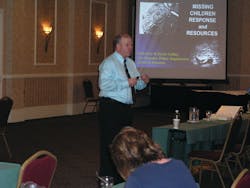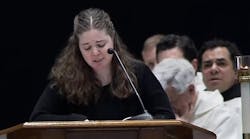From the conference’s opening moments to its closing remarks, the theme of 2012’s three-day meeting between various levels of law enforcement, private and public agencies and the families of the missing never lost its focus: Bring them home.
The “them” in this motto are the thousands of individuals across this nation who have disappeared. Some are children, others are adults, and all have one thing in common – someone, somewhere knows who they are. And the point of the Fox Valley Technical College, Criminal Justice Center for Innovation’s National Training Conference, held yearly in Appleton, Wisconsin, is to bring all sides of the missing persons issue to the same table. Attendees can attest that the conference has once again been a success.
Mixing testimony and training
The annual conference attracts criminal investigators from across the nation and, in some cases, foreign countries such as Great Britain and Canada, along with representatives from agencies like the National Center for Missing and Exploited Children, as well as the families of individuals who have disappeared. Keynote speakers in past years have included Ed Smart, father of Elizabeth Smart, who was abducted from her own bedroom, and Beth Holloway, mother of missing teenager Natalee Holloway, who disappeared while on a post high school graduation trip to Aruba.
This year, attendees heard from keynoter Carrie McGonigle, a Southern California resident whose teenage daughter, Amber Dubois, vanished while walking to school. Amber’s body was later found dumped in a remote wilderness. After being arrested for the murder of a second woman and attacking a third, the girls’ killer was sent to prison for the remainder of his life.
Lisa Murray, also a family member affected by the disappearance of a loved one, spoke to participants about the effects of not knowing what happened to a relative. Lisa’s sister, 16-year-old Jeffrey Lynn Smith, vanished from her Little Rock, Ark., neighborhood on Dec. 4, 1985. At that time police listed her as a runaway. Years after she failed to turn up, Lynn, as her family knew her, has been reclassified as endangered missing.
Murray told attendees that her elderly mother, now in her 80s, has found no solace since her daughter disappeared. The loss of her child haunts her on a daily basis and she agonizes over the fact that, at her age, she doesn’t have much longer to put the issue to rest. Murray says at this point the family is at peace with the idea that Lynn is now deceased – there has been no sign of her in the more than 25 years since she vanished. However, they want to recover her body, if at all possible, and take her to a family burial place to inter her next to Murray’s other sister, who died when she was a toddler.
“We just want closure,” Murray says.
Bodiless homicide investigations
Murray found comfort in the presentation by Dane County (Wisconsin) Assistant District Attorney Bob Kaiser and Madison, Wisc., Police Det. Marianne Flynn-Statz, an investigator with the department’s Sensitive Crimes Unit. Kaiser and Flynn-Statz recounted two cases they worked on together that resulted in successful prosecutions of bodiless homicides. Both cases were originally missing person cases.
In the case of Beth Kutz, a young mother of two who vanished on July 27, 2000, and has never been found, a jury argued their way to a conviction that landed Kutz’s estranged husband, Dan, in jail for life. A second case involving the disappearance of a flight instructor and mother of three has received national attention.
In 1976 when she disappeared, Jeannette Zapata was one of the youngest female flight instructors ever to receive her certification. Married to an abusive man who forced her into a life of deviant sexual behavior, Jeanette separated from him and obtained a court order keeping him away from her. It didn’t work. After abducting and killing his wife, Eugene Zapata managed to keep police investigators at bay for three decades. He then stashed her body where it could not be found, only disposing of her remains when police began reinvestigating the case.
Jeanette Zapata died during an argument with her husband in which he hit her many times over the head with a drafting tool and then strangled her. He wrapped her body in a tent and buried her on some property he owned, removing it when he decided to sell the property, and putting it in a storage locker. Alerted to renewed police interest in the case by a relative, Eugene Zapata cut the remains into pieces and disposed of the remains in a landfill.
Although the original jury on the case hung 11 to 1 for conviction, Eugene Zapata agreed to a plea deal in which he told police the truth about his former wife’s death in return for a reduced sentence of five years. Eugene Zapata was 69 years old when he agreed to the plea deal.
Kaiser told the crowd that the Zapata conviction was based strictly on circumstantial evidence. “The report of a missing person is potentially a criminal investigation and must be viewed that way by everyone in the investigation,” say Kaiser and Flynn-Statz.
The case, which remained open only three weeks before being closed after the initial report, was reopened in 2004 as a cold case. Investigators not only covered the same ground that the original detectives covered, but found new evidence to bring Eugene Zapata to trial. Among the most convincing evidence they found of Jeanette Zapata’s death was the total lack of proof that she still lived: There had been no bank account activity, her Social Security number had not been used, no passport had been issued and none of her licenses had been renewed.
Not every missing persons case can be treated as a homicide, but as Kaiser and Flynn-Statz proved, when there is sufficient circumstantial evidence, a homicide prosecution is possible
Tools of the search
The crowd also heard from seasoned missing persons investigators, a renowned forensic anthropologist, an expert in landfill searches and an advocate who operates a nonprofit aimed at bringing to light the problem of the missing mentally ill, addicts and the homeless. All brought different perspectives to the table.
Dr. Frederick Snow told police that, while crime scene investigators and processors do a good job of handling most scenes, when a body is discovered outdoors -– particularly after a lengthy period of time -– it is best to bring in a consulting forensic anthropologist. Snow says his profession is trained to notice details that others do not. He illustrated this by returning to several cases in which he consulted where small bones that proved crucial to the investigation were discovered after being overlooked by crime scene investigators.
Kevin Coffey, a 30-year veteran of the Lost Angeles Police Dept., spoke about the value of integrating volunteers into the missing persons investigatory process. Coffey told attendees that LAPD found that by using volunteers, the department could not only cover more investigative ground faster, but also kept down the cost of missing persons investigations in general. Coffey said that using volunteers has increased the department’s success rate in these cases.
Lee Reed, an officer with the City of Abilene Police Dept., conducted a seminar on the art and science of landfill searches. Reed, who breaks down the searches using mathematics and a scientific approach, told listeners that he had located the evidence sought by police in 20 of the 23 searches in which he had participated. Recovered evidence includes both bodies and weapons.
Libba Phillips, founder of Outpost for Hope, shared her personal story, which was also the basis for a Lifetime TV movie. Her sister, Ashley, is a mentally ill drug addict who has drifted throughout the country, often leaving her family scrambling to find her. Both law enforcement agencies and medical facilities have been hesitant to help Phillips and her family in their frequent searches for Ashley. Phillips told the crowd that, based on her experience, there are millions of individuals living off the grid in this nation. Many of these individuals have children that are endangered and disappear. Since no one is officially aware these kids exist they are at high risk for abuse, trafficking and prostitution. Phillips says she believes that many of those living on the streets are among the missing populations reported to police agencies.
Other speakers addressed subjects ranging from constitutional laws regarding search and seizure, including searching in exigent circumstances, working with DNA databases, human trafficking, wilderness searches and handling cases of runaway children. The closing speaker was the minor child of a missing woman who told the audience how he deals with not knowing where his mother might be.
The future
Next year’s conference will take place in Appleton in March. A few scholarships are available to help defray the cost of attendance. For more information, check out the website for the Fox Valley Technical Conference, Criminal Justice Center for Innovation.



